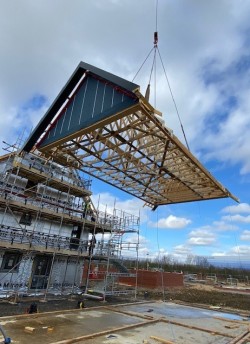Debi Lama, Key Account Manager for Affordable Housing at Stewart Milne Timber Systems, discusses why offsite construction coupled with a build fabric such as timber frame is key to reducing fuel poverty across the UK.
The rising cost of running a home set against a backdrop of economic uncertainty is a growing issue, now more so than ever before, as a result of the global COVID-19 pandemic. It is estimated that approximately 3.5 million households in the UK are classed as being in fuel poverty. While these figures from 2017 are the lowest since 2005-06, it is evident there is still more to be done. And with budgets likely to tighten even further over the coming months, it comes as no surprise that household running costs are a key consideration for homebuyers across the country.
Sustainable building used to be the exception rather than the rule, but the fact that buyer attitudes are shifting is forcing housebuilders to act. If they want to attract budget-conscious buyers, housebuilders now need to consider how to appeal to buyers who wish to reduce their overall living costs.
In response to calls for more sustainable housing, industry reports are increasingly signaling a move towards modern methods of construction (MMC) in the housebuilding sector. A phrase coined by the UK government, it acts as a definition and framework to encourage developers to adopt and champion construction practices which will speed up delivery, plug the skills gap, and crucially, be a driving force for a low carbon sustainable economy.
As demand for increased production continues to be driven by the government, it is crucial that low carbon sustainability remains front-of-mind – and this is where the build fabric itself becomes just as important as the construction method.
A natural, renewable, low-carbon material, timber is readily available, economically viable, versatile and is a carbon-neutral building material in itself – for every tree used in a timber frame home, many more are planted. This is in stark contrast to blocks and mortar, which is an energy-intensive and non-renewable method of construction. Offsite timber frame construction provides a building with a superior thermal envelope, requiring minimal maintenance and a ‘fit-and-forget’ solution for the lifetime of the building. For a home to be energy efficient, it must be well insulated and as airtight as possible. With timber construction retaining and reducing heat demand, the resulting building contributes quite considerably to reducing fuel poverty as heating bills tend to be lower, and the house warmer. Taking a ‘fabric first’ approach and using offsite timber frame construction on new developments is a proven means of ensuring sustainability, with low-carbon compliance at the very heart of the development, not only in the materials used, but also during the varying construction stages and for the remainder of its lifecycle.
Scotland is set to begin working with the construction sector to develop regulations which will ensure new homes consented from 2024, a year ahead of the rest of the UK, are required to use renewable or low carbon heat in a bid to further reduce fuel poverty, in line with the UK’s recent legislation to tackle the root causes of fuel poverty by 2040.
In the South of England, Milton Keynes and in Stratford-upon-Avon, the Housing Association L&Q (London & Quadrant) are working with us to build efficiently insulated homes for their homeowners and tenants using the award-winning Sigma® II timber frame build system. Using this system means that building performance is improved with better heat retention and subsequently reduced energy demand, resulting in a fuel-efficient dwelling. The Sigma® II system takes ‘whole life costing’ into account as well as risk and homeowner impact.
When building with timber frame, a home can be designed as one integrated system with a fabric first approach and energy efficiency locked into the home’s core: reducing the need for renewables, or wider newer technologies to be added on at a later date. Ultimately, this will save the homeowners money and gives them peace of mind in delivery of energy performance. Timber frame homes have a track record of superior energy efficiency and low embodied carbon. The homes are naturally warm in winter and yet cool in the summer, allowing residents to enjoy significantly lower heating bills overall.
The introduction of the Future Homes Standard by 2025 will help ensure newbuild homes are future-proofed with low-carbon heat and power as well as world-leading levels of energy efficiency – thus, tying in with the Chancellor’s pledge to reduce the use of fossil fuel in homes by 2025
As we look to the future, building in timber frame, combined with a fabric first approach, will be the most effective means of meeting major housebuilding and net-zero carbon targets sustainably. Not only is it affordable, but it also reduces long-term maintenance, while positively impacting the social agenda with more efficient homes, reducing energy bills for tenants and thereby contributing to housing associations drive to decrease fuel poverty.
For more information visit: www.stewartmilnetimbersystems.com
To view the article along with the complete magazine click here









